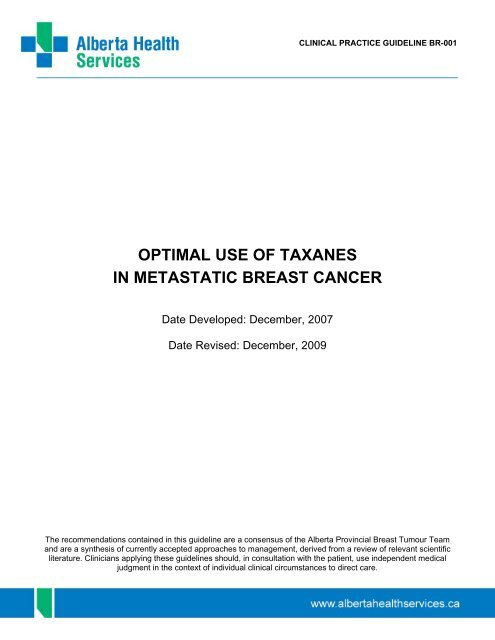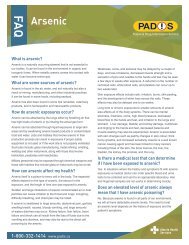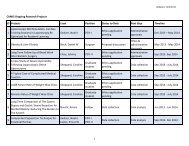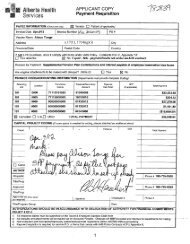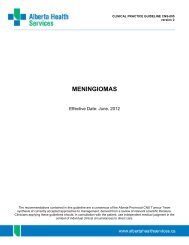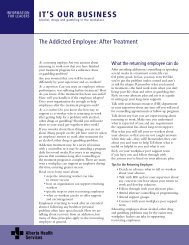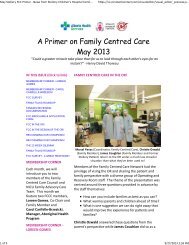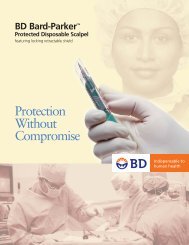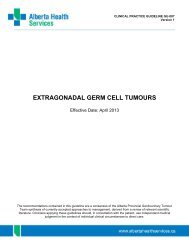taxanes in metastatic breast cancer - Alberta Health Services
taxanes in metastatic breast cancer - Alberta Health Services
taxanes in metastatic breast cancer - Alberta Health Services
You also want an ePaper? Increase the reach of your titles
YUMPU automatically turns print PDFs into web optimized ePapers that Google loves.
CLINICAL PRACTICE GUIDELINE BR-001<br />
OPTIMAL USE OF<br />
TAXANES<br />
IN METASTATIC BREAST CANCER<br />
Date Developed: December, 2007<br />
Date Revised: December, 2009<br />
The recommendations conta<strong>in</strong>ed <strong>in</strong> this guidel<strong>in</strong>e are a consensus of the <strong>Alberta</strong> Prov<strong>in</strong>cial Breast Tumour Team<br />
and are a synthesis of currently accepted approaches to management, derived from a review of relevant scientific<br />
literature. Cl<strong>in</strong>icians apply<strong>in</strong>g these guidel<strong>in</strong>es should, <strong>in</strong> consultation with the patient, use <strong>in</strong>dependent medical<br />
judgment <strong>in</strong> the context of <strong>in</strong>dividual cl<strong>in</strong>ical circumstances to direct care.
BACKGROUND<br />
CLINICAL PRACTICE GUIDELINE BR-001<br />
In 2007, <strong>breast</strong> <strong>cancer</strong> is projected to be the second most commonly diagnosed <strong>cancer</strong>,<br />
and the third<br />
lead<strong>in</strong>g cause of <strong>cancer</strong>-related mortality <strong>in</strong> Canadian women. lead<strong>in</strong>g cause of potential<br />
of <strong>cancer</strong>-related<br />
ith <strong>metastatic</strong><br />
Canadian women <strong>in</strong><br />
ith a <strong>metastatic</strong> relapse<br />
eatment <strong>in</strong> <strong>metastatic</strong><br />
of quality of life.<br />
1 Cancer was the<br />
years of life lost <strong>in</strong> Canadian adults <strong>in</strong> 2003 and <strong>breast</strong> <strong>cancer</strong> accounted for 18.3%<br />
premature mortality <strong>in</strong> women. 1 Approximately 6% of women are diagnosed <strong>in</strong>itially w<br />
disease. 2 This will account for just over 1300 new <strong>breast</strong> <strong>cancer</strong> diagnoses <strong>in</strong><br />
2007. 1,2 Unfortunately, many women with early <strong>breast</strong> <strong>cancer</strong> will be diagnosed w<br />
<strong>in</strong> the years follow<strong>in</strong>g local-regional and systemic adjuvant therapies. The goals of tr<br />
<strong>breast</strong> <strong>cancer</strong> <strong>in</strong>clude prolongation of survival, symptom control and ma<strong>in</strong>tenance<br />
In <strong>Alberta</strong>, chemotherapy for <strong>breast</strong> <strong>cancer</strong> is prescribed at tertiary, associate and community<br />
<strong>cancer</strong><br />
cl<strong>in</strong>ics, which are all affiliated with the <strong>Alberta</strong> Cancer Board. The literature on <strong>taxanes</strong> and <strong>breast</strong> <strong>cancer</strong><br />
has been grow<strong>in</strong>g exponentially s<strong>in</strong>ce the mid-1990’s. In the absence of an evidence-based prov<strong>in</strong>cial<br />
guidel<strong>in</strong>e, it is expected then, that there is regional variability <strong>in</strong> taxane prescription. The<br />
objective of<br />
creat<strong>in</strong>g a prov<strong>in</strong>cial guidel<strong>in</strong>e on the optimal use of <strong>taxanes</strong> <strong>in</strong> the management of <strong>metastatic</strong> <strong>breast</strong><br />
<strong>cancer</strong> is to promote evidence-based consistency <strong>in</strong> practice, and hence, equitable access for patients to<br />
appropriate therapies.<br />
Guidel<strong>in</strong>es for taxane use <strong>in</strong> the management of <strong>metastatic</strong> <strong>breast</strong> <strong>cancer</strong> have previously been published.<br />
The current effort will<br />
be to systematically adapt recommendations of others, and create de novo<br />
recommendations to account for recent evidence.<br />
GUIDELINE GOALS AND OBJECTIVES<br />
To outl<strong>in</strong>e the optimal cl<strong>in</strong>ical use of <strong>taxanes</strong> <strong>in</strong> the management of <strong>metastatic</strong> <strong>breast</strong><br />
<strong>cancer</strong><br />
GUIDELINE QUESTIONS<br />
1. What taxane reg imens can be offered to anthracycl<strong>in</strong>e-naïve patients with <strong>metastatic</strong> <strong>breast</strong> <strong>cancer</strong><br />
(where HER2 is not over-expressed)?<br />
2. What taxane regimens can be offered to anthracycl<strong>in</strong>e-pre-treated/resistant patients<br />
with <strong>metastatic</strong><br />
<strong>breast</strong> <strong>cancer</strong> (where HER2 is not over-expressed)?<br />
3. What taxane regimens can be offered to patients with <strong>metastatic</strong> <strong>breast</strong> <strong>cancer</strong><br />
where HER2 is overexpressed?<br />
4. What are the benefits (time to progression, progression free survival, overall survival, quality of life)?<br />
5. What are the potential toxicities?<br />
DEVELOPMENT PANEL<br />
This guidel<strong>in</strong>e was reviewed and endorsed by the <strong>Alberta</strong> Prov<strong>in</strong>cial Breast Tumour Team. Members of<br />
the <strong>Alberta</strong> Prov<strong>in</strong>cial Breast Tumour Team <strong>in</strong>clude medical oncologists, radiation oncologists, surgical<br />
oncologists, nurses, pathologists, and pharmacists. Evidence was selected and reviewed by a work<strong>in</strong>g<br />
group comprised of members from the <strong>Alberta</strong> Prov<strong>in</strong>cial Breast Tumour Team and a Knowledge<br />
Management Specialist from the Guidel<strong>in</strong>e Utilization Resource Unit.
SEARCH STRATEGY<br />
CLINICAL PRACTICE GUIDELINE BR-001<br />
A systematic search for relevant, exist<strong>in</strong>g practice guidel<strong>in</strong>es and other evidence was<br />
conducted of:<br />
MEDLINE, Pub Med, CINAHL, EMBASE, CancerLit, the Cochrane Library, the Physician<br />
Data Query<br />
database, practice guidel<strong>in</strong>e INTERNET sites, and conference proceed<strong>in</strong>gs<br />
from the American Society of<br />
Cl<strong>in</strong>ical Oncology (ASCO) and the San Antonio Breast Cancer Symposium (SA). The follow<strong>in</strong>g search<br />
terms were used Taxane* Exp., Taxanes Exp., <strong>metastatic</strong> <strong>breast</strong> <strong>cancer</strong> exp., metastases,<br />
<strong>breast</strong> tumour,<br />
<strong>breast</strong> tumor, Women exp., add<strong>in</strong>g AND/OR Anthracycl<strong>in</strong>e exp., Anthracycl<strong>in</strong>es exp.<br />
The search<br />
for practice guidel<strong>in</strong>es was conducted for the period January 1, 2000 to August 31, 2007. As<br />
the most up-to-date evidence-based<br />
practice guidel<strong>in</strong>e selected for the adaptation process was published<br />
<strong>in</strong> 2003, the search for other evidence was conducted for the period January 1, 2003 to August 5, 2009.<br />
Other evidence cited <strong>in</strong> bibliographies and brought forward dur<strong>in</strong>g edit<strong>in</strong>g and review was collected as<br />
necessary.<br />
DEVELOPMENT PROCESS<br />
This guidel<strong>in</strong>e was developed<br />
by the <strong>Alberta</strong> <strong>Health</strong> <strong>Services</strong> – Cancer Corridor, Prov<strong>in</strong>cial Breast Tumour<br />
3<br />
Group Guidel<strong>in</strong>e Panel us<strong>in</strong>g the ADAPTE process and some aspects of the Practice Guidel<strong>in</strong>es<br />
Development Cycle. pharmacist, one<br />
potential conflicts of<br />
the development process started (none disclosed). The <strong>Alberta</strong> <strong>Health</strong> <strong>Services</strong> – Cancer<br />
Corridor.<br />
4 Panel members <strong>in</strong>cluded four medical oncologists, one oncology<br />
oncology nurse, and one methodologist. All panel members disclosed <strong>in</strong>formation on<br />
<strong>in</strong>terest before<br />
Corridor, Prov<strong>in</strong>cial Breast Tumour Group Guidel<strong>in</strong>e Panel is editorially <strong>in</strong>dependent of the <strong>Alberta</strong> <strong>Health</strong><br />
<strong>Services</strong> – Cancer<br />
Titles and abstracts<br />
(where possible) were assessed <strong>in</strong>dependently by two reviewers for relevance. A full<br />
copy of the publication or abstract (if only a conference proceed<strong>in</strong>g) was obta<strong>in</strong>ed<br />
if either reviewer<br />
considered the literature to be<br />
relevant.<br />
These documents were assessed for <strong>in</strong>clusion and exclusion<br />
criteria as follows:<br />
For practice guidel<strong>in</strong>es:<br />
1. Perta<strong>in</strong><strong>in</strong>g to <strong>in</strong>dividuals with <strong>metastatic</strong> (not locally advanced) <strong>breast</strong> <strong>cancer</strong>, anthracycl<strong>in</strong>e<br />
naïve or<br />
pre-treated.<br />
2. Perta<strong>in</strong><strong>in</strong>g to palliative chemotherapy<br />
with reference to taxane or taxane-conta<strong>in</strong><strong>in</strong>g regimens (taxane<br />
= docetaxel, paclitaxel or nab-paclitaxel).<br />
3. Published <strong>in</strong> the English language.<br />
4. Recommendations clearly l<strong>in</strong>ked to the support<strong>in</strong>g literature. A comprehensive review of the exist<strong>in</strong>g,<br />
relevant evidence +/- meta-analyses of data where appropriate, is presented.<br />
For other evidence:<br />
1. Systematic reviews, randomized phase III cl<strong>in</strong>ical trials and randomized phase II cl<strong>in</strong>ical trials where<br />
data on time to progression, progression free survival, overall survival or quality of life (plus/m<strong>in</strong>us data<br />
on response rates) was reported.<br />
2. Perta<strong>in</strong><strong>in</strong>g to <strong>in</strong>dividuals with <strong>metastatic</strong> (not locally advanced) <strong>breast</strong> <strong>cancer</strong>, anthracycl<strong>in</strong>e naïve or<br />
pre-treated.
CLINICAL PRACTICE GUIDELINE BR-001<br />
3. Perta<strong>in</strong><strong>in</strong>g to palliative chemotherapy where a taxane or taxane-conta<strong>in</strong><strong>in</strong>g regimen is compared with a<br />
non-taxane chemotherapy regimen or a different taxane chemotherapy regimen (taxane = docetaxel,<br />
paclitaxel<br />
or nab-paclitaxel).<br />
4. Published <strong>in</strong> the English language.<br />
Data synthesis<br />
The Comprehensive Meta-analysis Package Version 2 was used for data pool<strong>in</strong>g where deemed<br />
appropriate. Random effects models were used to obta<strong>in</strong> odds ratios or rate ratios.<br />
External review<br />
istributed to other members of the <strong>Alberta</strong> Cancer Board Prov<strong>in</strong>cial Breast Tumour<br />
Group with representation from medical oncology, nurs<strong>in</strong>g and pharmacy for review. Reviewers were<br />
published <strong>in</strong> Elit et al) 5<br />
A draft report was d<br />
asked to read the guidel<strong>in</strong>e, complete a questionnaire (based on the questionnaire<br />
and provide other written comments.<br />
TARGET POPULATION<br />
This guidel<strong>in</strong>e is <strong>in</strong>tended<br />
for use by chemotherapy-prescrib<strong>in</strong>g physicians, nurse practitioners, and<br />
pharmacists with<strong>in</strong> <strong>Alberta</strong> <strong>Health</strong> <strong>Services</strong> – Cancer Care and the <strong>Alberta</strong> <strong>Health</strong> <strong>Services</strong> Pharmacy &<br />
Therapeutics Committee.<br />
The recommendations <strong>in</strong> this guidel<strong>in</strong>e are <strong>in</strong>tended for <strong>in</strong>dividuals with<br />
<strong>metastatic</strong> <strong>breast</strong> <strong>cancer</strong> (anthracycl<strong>in</strong>e naïve or pre-treated/resistant) who are eligible<br />
for palliative<br />
chemotherapy (hormone refractory and/or rapidly progressive disease, adequate performance<br />
status and<br />
organ function).<br />
RECOMMENDATIONS<br />
Anthracycl<strong>in</strong>e<br />
Naïve Patients<br />
d by taxane at the time<br />
al benefit has not been<br />
g/m 2 1. If s<strong>in</strong>gle agent chemotherapy is preferred, sequential anthracycl<strong>in</strong>e followe<br />
of disease progression, or vice versa, are acceptable alternatives. A surviv<br />
shown for start<strong>in</strong>g with a taxane.<br />
a. The follow<strong>in</strong>g q3 weekly regimen is recommended: Docetaxel 100 m every 3 weeks.<br />
b. Weekly taxane regimens are also reasonable options if m<strong>in</strong>imization<br />
of risk for certa<strong>in</strong><br />
toxicities associated with docetaxel every 3 weeks is desired:<br />
i. Docetaxel 35 - 40 mg/m weeks.<br />
ii. Paclitaxel 80 - 90 mg/m weekly.<br />
2 weekly x3 q4 weeks or weekly x6 q8<br />
2<br />
2. If comb<strong>in</strong>ation chemotherapy is preferred, non-taxane/anthracycl<strong>in</strong>e and taxane/anthracycl<strong>in</strong>e<br />
regimens are acceptable alternatives. Taxane/anthracycl<strong>in</strong>e comb<strong>in</strong>ations are superior with<br />
respect to overall response and progression free survival, but have not been shown to improve<br />
overall survival. Additionally, an overall survival benefit for us<strong>in</strong>g a taxane/anthracycl<strong>in</strong>e<br />
comb<strong>in</strong>ation over planned sequential s<strong>in</strong>gle agent anthracycl<strong>in</strong>e followed by s<strong>in</strong>gle agent taxane<br />
(before disease progression), or at the time of disease progression, has not been shown.<br />
Regard<strong>in</strong>g possible taxane/anthracycl<strong>in</strong>e regimens, doublet docetaxel or paclitaxel plus doxorubic<strong>in</strong><br />
or epirubic<strong>in</strong>, and triplet docetaxel + doxorubic<strong>in</strong> + cyclophosphamide have been studied.
Anthracycl<strong>in</strong>e Pretreated/Resistant Patients<br />
CLINICAL PRACTICE GUIDELINE BR-001<br />
d. S<strong>in</strong>gle agent<br />
on-taxane/nonxel<br />
100 mg/m 2 3. If s<strong>in</strong>gle agent chemotherapy is preferred, a taxane regimen is recommende<br />
<strong>taxanes</strong> appear to improve overall survival and response compared with n<br />
anthracycl<strong>in</strong>e regimens.<br />
a. The follow<strong>in</strong>g q3 weekly regimen<br />
is recommended: Doceta<br />
every 3 weeks.<br />
b. Weekly taxane regimens are also reasonable options if m<strong>in</strong>imization of risk for certa<strong>in</strong><br />
toxicities associated with docetaxel every 3 weeks is desired:<br />
i. Docetaxel 35 - 40 mg/m q8 weeks.<br />
2 weekly x3 q4 weeks or weekly x6<br />
ii. Paclitaxel 80 - 90 mg/m 2 weekly.<br />
4. If comb<strong>in</strong>ation chemotherapy is preferred, taxane/non-anthracycl<strong>in</strong>e regimens are recommended.<br />
Taxane/non-anthracycl<strong>in</strong>e regimens are superior with respect to overall survival and response<br />
compared with s<strong>in</strong>gle agent <strong>taxanes</strong>. Def<strong>in</strong>itive survival data with taxane/non-anthracycl<strong>in</strong>e<br />
comb<strong>in</strong>ations compared with sequential s<strong>in</strong>gle agent taxane followed<br />
by s<strong>in</strong>gle agent nontaxane/non-anthracycl<strong>in</strong>e<br />
(at progression) is not available.<br />
The follow<strong>in</strong>g taxane/non-anthracycl<strong>in</strong>e regimens should be options:<br />
• Docetaxel 75 mg/m weeks.<br />
eks.<br />
g/m days 1 & 8, q3 weeks.<br />
2 day 1 + capecitab<strong>in</strong>e 1250 mg/m 2 BID days 1-14, q3<br />
• Docetaxel 75 mg/m 2 day 1 + gemcitab<strong>in</strong>e 1000 mg/m 2 days 1 & 8, q3 we<br />
• Paclitaxel 175 mg/m 2 2<br />
day 1 + gemcitab<strong>in</strong>e 1250 m<br />
Anthracycl<strong>in</strong>e naïve or pretreated/resistant patients with<br />
paclitaxel or docetaxel <strong>in</strong>tolerance<br />
5. In the sett<strong>in</strong>g of an <strong>in</strong>tolerance to paclitaxel or docetaxel (severe <strong>in</strong>fusion reaction considered to be<br />
ation of a taxane,<br />
xel regimens should be<br />
00 - 150 mg/m 2 due to the vehicle of the <strong>taxanes</strong> or severe toxicity from previous adm<strong>in</strong>istr<br />
<strong>in</strong>clud<strong>in</strong>g corticosteroid <strong>in</strong>tolerance) the follow<strong>in</strong>g s<strong>in</strong>gle agent nab-paclita<br />
options where docetaxel or paclitaxel would otherwise be prescribed:<br />
a. Nab-paclitaxel 260-300 mg/m<br />
weekly x3 q4 weeks.<br />
2 q3 weeks.<br />
b. Nab-paclitaxel 1<br />
Anthracycl<strong>in</strong>e naïve or pretreated/resistant<br />
patients where HER2 is over-expressed<br />
6. A taxane/trastuzumab comb<strong>in</strong>ation is recommended up front. The addition of trastuzumab to a<br />
taxane has been shown to improve overall survival and response. Although the addition of<br />
trastuzumab to anthracycl<strong>in</strong>e regimens has also been shown to improve overall survival and<br />
response, the <strong>in</strong>cidence of cardiac failure is unacceptable. The addition of carboplat<strong>in</strong> to<br />
taxane/trastuzumab comb<strong>in</strong>ations has not yet been shown to improve overall survival or<br />
consistently <strong>in</strong>crease response.<br />
The strongest evidence is for the follow<strong>in</strong>g s<strong>in</strong>gle agent taxane regimens plus weekly trastuzumab:<br />
• Docetaxel 100 mg/m 2 q3 weeks.<br />
• Paclitaxel 175 mg/m 2 q3 weeks.
DISCUSSION<br />
Recommendation #1<br />
Recommendations from exist<strong>in</strong>g guidel<strong>in</strong>es<br />
CLINICAL PRACTICE GUIDELINE BR-001<br />
s<strong>in</strong>gle agent<br />
. 6 The NICE guidel<strong>in</strong>e<br />
atients. 7<br />
The CCO guidel<strong>in</strong>e recommends that patients who would be offered treatment with a<br />
anthracycl<strong>in</strong>e could also be offered s<strong>in</strong>gle agent docetaxel 100 mg/m 2 every 3 weeks<br />
does not give guidance with respect to s<strong>in</strong>gle agent <strong>taxanes</strong> <strong>in</strong> anthracycl<strong>in</strong>e naïve p<br />
The BCCA and CECOG statements<br />
do not recommend a s<strong>in</strong>gle agent taxane as <strong>in</strong>itial therapy <strong>in</strong> a patient<br />
9, 11<br />
who is anthracycl<strong>in</strong>e naïve and who has <strong>metastatic</strong> <strong>breast</strong> <strong>cancer</strong> where HER2 is not over-expressed.<br />
The NCCN does not differentiate anthracycl<strong>in</strong>e-naïve and pre-treated/resistant<br />
patients but suggests that<br />
a variety of s<strong>in</strong>gle agent taxane regimens can be considered. 10<br />
Other evidence considered by this panel<br />
le agent<br />
n = 919) from three<br />
l<strong>in</strong>e were 1.01 (CI 0.97rates<br />
were similar: 38% for the s<strong>in</strong>gle<br />
agent taxane and 33% for the s<strong>in</strong>gle agent anthracycl<strong>in</strong>e. Piccart et al 12 po<strong>in</strong>t out that there was<br />
survival for the<br />
he EORTC trial 14 that<br />
weeks. The metaof<br />
the same three trials<br />
l were found. Ghersi et al, 13 Two meta-analyses have looked at the question of s<strong>in</strong>gle agent <strong>taxanes</strong> versus s<strong>in</strong>g<br />
anthracycl<strong>in</strong>es. The meta-analysis by Piccart et al pooled <strong>in</strong>dividual patient data (<br />
randomized trials.<br />
however, looked at time to<br />
s.<br />
12 The hazard ratios for the taxane compared with the anthracyc<br />
1.26) for death and 1.19 (CI 1.04 – 1.36) for progression. Response<br />
significant heterogeneity with respect to the f<strong>in</strong>d<strong>in</strong>g of improved progression free<br />
anthracycl<strong>in</strong>e compared with the taxane, and that this result was largely driven by t<br />
compared paclitaxel 175 mg/m 2 every 3 weeks with doxorubic<strong>in</strong> 75 mg/m 2 every 3<br />
analysis by Ghersi et al extracted data from published trials. 13 In their analysis<br />
exam<strong>in</strong>ed by Piccart et al, 12 similar resu ts<br />
progression and did not f<strong>in</strong>d a difference between the taxane and anthracycl<strong>in</strong>e arm<br />
With respect to toxicities reported <strong>in</strong> the trials <strong>in</strong>cluded <strong>in</strong> the meta-analyses, there was<br />
more sensory<br />
peripheral neuropathy <strong>in</strong> the taxane arms, but more febrile neutropenia, mucositis, nausea/vomit<strong>in</strong>g,<br />
cardiac failure and toxic deaths <strong>in</strong> the anthracycl<strong>in</strong>e arms. alyzed <strong>in</strong> all three of<br />
he toxicities of<br />
14-16 Quality of life was an<br />
the trials and there was no significant difference <strong>in</strong> the treatment groups with respect to physical, social<br />
and emotional function<strong>in</strong>g, and relationship with physician. 14-16 In one of the trials, t<br />
doxorubic<strong>in</strong> were offset by better symptom control. 14<br />
In the systematic reviews, the <strong>taxanes</strong> have not been compared <strong>in</strong> subgroup analyses. In the EORTC<br />
trial 14 <strong>in</strong>cluded <strong>in</strong> the meta-analyses, overall survival was <strong>in</strong>ferior <strong>in</strong> the paclitaxel group (15.6 versus 18.3<br />
months). One phase III trial randomized patients with anthracycl<strong>in</strong>e-pre-treated <strong>metastatic</strong> <strong>breast</strong> <strong>cancer</strong><br />
to receive either docetaxel 100 mg/m 2 or paclitaxel 175 mg/m 2 every three weeks. 17 Overall survival and<br />
time to progression was significantly better for the docetaxel arm at the expense of greater hematologic<br />
and non-hematologic toxicities.<br />
The current panel agreed to <strong>in</strong>clude weekly taxane regimens as options. The evidence and rationale is<br />
largely drawn from the anthracycl<strong>in</strong>e pre-treated sett<strong>in</strong>g and is discussed under Recommendation #3.
Summary Statement<br />
CLINICAL PRACTICE GUIDELINE BR-001<br />
The CCO recommendation was adapted. The current panel acknowledged the results<br />
of 2 meta-analyses,<br />
the <strong>in</strong>dividual trial data <strong>in</strong>cluded <strong>in</strong> the meta-analyses, one study of docetaxel versus paclitaxel q3 weekly<br />
(from the anthracycl<strong>in</strong>e<br />
pre-treated sett<strong>in</strong>g) <strong>in</strong> support of this recommendation. Includ<strong>in</strong>g weekly taxane<br />
regimens as options was a de novo addition.<br />
Recommendation #2<br />
Recommendations from exist<strong>in</strong>g guidel<strong>in</strong>es<br />
be considered as<br />
ed data for<br />
thracycl<strong>in</strong>e comb<strong>in</strong>ations. It recommends aga<strong>in</strong>st such comb<strong>in</strong>ation therapy for the reason<br />
l therapy was unknown. 7<br />
The CCO guidel<strong>in</strong>e states docetaxel or paclitaxel <strong>in</strong> comb<strong>in</strong>ation with doxorubic<strong>in</strong> can<br />
options. 6 This is <strong>in</strong> contrast to the NICE guidel<strong>in</strong>e. The NICE guidel<strong>in</strong>e only evaluat<br />
docetaxel/an<br />
that the effectiveness of sequentia<br />
s options. 10 The NCCN statement lists docetaxel or paclitaxel <strong>in</strong> comb<strong>in</strong>ation with doxorubic<strong>in</strong> a<br />
The BCCA<br />
and CECOG statements do not consider taxane/anthracycl<strong>in</strong>e comb<strong>in</strong>ations as options<br />
for anthracycl<strong>in</strong>e<br />
naïve patients. 9,11<br />
Other evidence considered by this panel<br />
The Piccart and Ghersi meta-analyses have also addressed the issue of taxane/anthracycl<strong>in</strong>e<br />
regimens<br />
versus non-taxane/anthracycl<strong>in</strong>e comb<strong>in</strong>ation therapy. idual patient data<br />
was the taxane <strong>in</strong> the<br />
the non-<br />
I 0.85 – 0.99) for<br />
ens (57 versus 46%).<br />
ive disease) would benefit<br />
from taxane/anthracycl<strong>in</strong>e regimens but this hypothesis was not supported <strong>in</strong> subgroup analyses. Ghersi<br />
eported time-to-event<br />
ther 2 trials. The<br />
comb<strong>in</strong>ations were<br />
. Five trials reported <strong>in</strong>formation on<br />
tio for response for the taxane/anthracycl<strong>in</strong>e regimens compared with the nonovided<br />
adequate data on<br />
ore leukopenia and<br />
neurotoxicity, but less nausea and vomit<strong>in</strong>g. There was no difference <strong>in</strong> quality of life.<br />
12, 13 Piccart et al <strong>in</strong>cluded <strong>in</strong>div<br />
from 8 randomized trials. Docetaxel was the taxane <strong>in</strong> 4 of the trials, and paclitaxel<br />
other 4 trials. The hazard ratios for the taxane/anthracycl<strong>in</strong>e regimen compared with<br />
taxane/anthracycl<strong>in</strong>e comb<strong>in</strong>ation were 0.95 (CI 0.88 - 1.03) for death and 0.92 (C<br />
progression. Response rates significantly favoured the taxane/anthracycl<strong>in</strong>e regim<br />
The authors postulated that patients with worse prognosis (visceral or ER-negat<br />
et al 13 identified 9 potentially eligible studies for this question but only 3 studies had r<br />
data. Docetaxel was the taxane <strong>in</strong> 1 of the trials and paclitaxel was the taxane <strong>in</strong> the o<br />
hazard ratios for the taxane/anthracycl<strong>in</strong>e regimens compared with the anthracycl<strong>in</strong>e<br />
0.88 (CI 0.76 - 1.02) for death and 0.81 (CI 0.70 – 0.94) for progression<br />
response. The odds ra<br />
taxane/anthracycl<strong>in</strong>e comb<strong>in</strong>ations was 1.7 (CI 1.39 – 2.08). Four studies pr<br />
toxicity. The taxane/anthracycl<strong>in</strong>e regimens were associated with significantly m<br />
Aga<strong>in</strong> the systematic reviews have not compared the <strong>taxanes</strong> <strong>in</strong> subgroup analyses. One phase III trial<br />
compared docetaxel + doxorubic<strong>in</strong> with paclitaxel + doxorubic<strong>in</strong> has been published. 18 Outcomes were not<br />
significantly different <strong>in</strong> terms of median overall survival (22.6 versus 24.1 months) and response (40<br />
versus 42%). More peripheral neuropathy was observed <strong>in</strong> the paclitaxel group. There was no difference<br />
between the groups with respect to quality of life although some sub-scores favoured the<br />
docetaxel/doxorubic<strong>in</strong> group.<br />
The current panel was also <strong>in</strong>terested <strong>in</strong> the issue of taxane/anthracycl<strong>in</strong>e comb<strong>in</strong>ations versus<br />
sequenc<strong>in</strong>g of s<strong>in</strong>gle agent anthracycl<strong>in</strong>e to s<strong>in</strong>gle agent taxane. Two trials have exam<strong>in</strong>ed planned
CLINICAL PRACTICE GUIDELINE BR-001<br />
ndomized women with<br />
or doxorubic<strong>in</strong> 75<br />
were anthracycl<strong>in</strong>e<br />
+ doxorubic<strong>in</strong> followed<br />
or median overall<br />
nths) or overall<br />
/m 2 + epirubic<strong>in</strong> 90<br />
g/m 2 q3 weeks x4. 20<br />
s), median<br />
57.6%). Quality of life<br />
arm. Sledge et al 16<br />
c<strong>in</strong>g of s<strong>in</strong>gle agents at<br />
doxorubic<strong>in</strong> 50 mg/m 2 sequential anthracycl<strong>in</strong>e followed by taxane (before progression).<br />
q3<br />
t progression, and<br />
2 16<br />
q3 weeks at progression. Just over<br />
ts <strong>in</strong> the s<strong>in</strong>gle agent arms actually did cross over to the alternate s<strong>in</strong>gle agent at<br />
progression. No significant differences were found for median overall survival between the comb<strong>in</strong>ation<br />
ime to failure was<br />
rm compared to either<br />
19, 20 Alba et al ra<br />
<strong>metastatic</strong> <strong>breast</strong> <strong>cancer</strong> to docetaxel 75 mg/m 2 + doxorubic<strong>in</strong> 50 mg/m 2 q3 weeks x6<br />
mg/m 2 q3 weeks x3 followed by docetaxel 100 mg/m 2 q3 weeks x3. 19 Women who<br />
pretreated and randomized to the comb<strong>in</strong>ation arm, received 3 cycles of docetaxel<br />
by 3 cycles of docetaxel 100 mg/m 2 q3 weeks. There were no significant differences f<br />
survival (21.8 versus 22.3 months), median time to progression (9.2 versus 10.5 mo<br />
response (51 versus 61%). Conte et al randomized participants to paclitaxel 200 mg<br />
mg/m 2 q3 weeks x8 or epirubic<strong>in</strong> 120 mg/m 2 q3 weeks x4 followed by paclitaxel 250 m<br />
There were no significant differences for median overall survival (20 versus 26 month<br />
progression free survival (10.8 versus 11 months) or overall response (58.5 versus<br />
assessment suggested better function<strong>in</strong>g and symptom control for the comb<strong>in</strong>ation<br />
were able to exam<strong>in</strong>e the issue of taxane/anthracycl<strong>in</strong>e comb<strong>in</strong>ation versus sequen<br />
progression. The three arms <strong>in</strong> this trial were as follows: paclitaxel 150 mg/m 2 +<br />
weeks, paclitaxel 175 mg/m 2 q3 weeks followed by doxorubic<strong>in</strong> 60 mg/m 2 q3 weeks a<br />
doxorubic<strong>in</strong> 60 mg/m 2 q3 weeks followed by paclitaxel 175 mg/m<br />
half of participan<br />
arm and either sequential s<strong>in</strong>gle agent arm (22 versus 22 versus 18.9 months). T<br />
significantly longer and response rate was significantly higher for the comb<strong>in</strong>ation a<br />
sequential s<strong>in</strong>gle agent arm.<br />
Summary statement<br />
The CCO recommendation was adapted.<br />
The current panel has acknowledged the results of 2 meta-<br />
analyses and one trial of docetaxel + doxorubic<strong>in</strong> versus paclitaxel + doxorubic<strong>in</strong> <strong>in</strong> support<br />
of this<br />
recommendation. Data on taxane/anthracycl<strong>in</strong>e comb<strong>in</strong>ations versus sequential s<strong>in</strong>gle<br />
agents was also<br />
considered.<br />
Recommendation #3<br />
Recommendations from exist<strong>in</strong>g guidel<strong>in</strong>es<br />
c axel are options. The<br />
CCO guidel<strong>in</strong>e takes the stance that the evidence for us<strong>in</strong>g docetaxel q3 weeks is more consistent and<br />
based on larger trials than the evidence for us<strong>in</strong>g paclitaxel q3 weeks. The CCO 6 The CCO<br />
suggests reserv<strong>in</strong>g<br />
weekly taxane regimens (options not specified) for those who are elderly, have a low performance status<br />
or would prefer avoid<strong>in</strong>g some of the toxicities associated with <strong>taxanes</strong> q3 weeks. The NICE guidel<strong>in</strong>e is<br />
non-directive <strong>in</strong> terms of which s<strong>in</strong>gle agent regimens can be considered.<br />
6 and NICE 7 guidel<strong>in</strong>es both suggest that s<strong>in</strong>gle agent docetaxel and pa lit<br />
6<br />
It was noted that the recent BCCA, 9 NCCN 10 and CECOG 11 statements also suggest that s<strong>in</strong>gle agent<br />
<strong>taxanes</strong> are options. BCCA 9 considers docetaxel q3 weeks and weekly, plus paclitaxel q3 weeks. NCCN 10<br />
considers both docetaxel and paclitaxel q3 weeks and weekly, plus nab-paclitaxel q3 weeks. CECOG 11 is<br />
non-directive <strong>in</strong> terms of which s<strong>in</strong>gle agent regimens can be considered.
Other evidence considered by this panel<br />
CLINICAL PRACTICE GUIDELINE BR-001<br />
Compared with non-taxane/non-anthracycl<strong>in</strong>e regimens, s<strong>in</strong>gle agent <strong>taxanes</strong> appear<br />
to improve overall<br />
survival and response. It was possible to pool overall survival data from 4 of the 5 studies outl<strong>in</strong>ed <strong>in</strong> Table<br />
1. as 0.68 (95% CI 0.36 – 1.3) us<strong>in</strong>g a random<br />
23 (95% CI 1.43 –<br />
21-25 Figure 1 shows that the odds ratio (OR) for death w<br />
effects model with a trend favour<strong>in</strong>g the s<strong>in</strong>gle agent taxane. Overall response rate data from all 5 studies<br />
<strong>in</strong> Table 1 was pooled. Figure 2 shows that the rate ratio for overall response was 2.<br />
3.49) us<strong>in</strong>g a random effects model, favour<strong>in</strong>g the s<strong>in</strong>gle agent taxane.<br />
hree of the five<br />
regimen. The three<br />
. Secondly, one<br />
l 175 mg/m 2 Paclitaxel 175 mg/m<br />
both q3 weeks showed<br />
cetaxel was however, at<br />
sensory peripheral<br />
2 q3 weeks was not <strong>in</strong>cluded as an option by the panel. Firstly, t<br />
studies <strong>in</strong>cluded <strong>in</strong> Table 1 were of docetaxel versus a non-taxane/non-anthracycl<strong>in</strong>e<br />
docetaxel studies were much larger <strong>in</strong> comparison to the two paclitaxel studies<br />
randomized phase III trial of docetaxel 100 mg/m 2 versus paclitaxe<br />
significantly longer median survival <strong>in</strong> the docetaxel group (15.4 versus 12.7 months) and significantly<br />
longer median time to progression (5.7 versus 3.6 months) [17]. The benefit of do<br />
the cost of more hematologic and non-hematologic toxicity: febrile neutropenia (14.9 versus 1.8%),<br />
stomatitis/mucositis (10.8 versus 0%), nausea/vomit<strong>in</strong>g (8.6 versus 2.7%) and<br />
neuropathy (7.2 versus 4.1%). Quality of life scores were not significantly different.<br />
Evidence for the effectiveness, and perhaps more favourable toxicity profiles, associated<br />
with weekly<br />
taxane regimens is mount<strong>in</strong>g.<br />
Weekly docetaxel: One phase III trial compared docetaxel 35-40 mg/m 4 weeks with<br />
h respect to median<br />
.5 versus 5.7 months).<br />
n the weekly group,<br />
igue (13.5 versus<br />
eeks versus docetaxel 100<br />
l survival for the<br />
(5.7 versus 5.3 months)<br />
febrile neutropenia<br />
ersus 17.1%) and<br />
e slightly more<br />
ersus 12.2%), and more<br />
gest quite a variable<br />
idel<strong>in</strong>e.<br />
2 weekly x3 q<br />
docetaxel 75-100 mg/m 2 q3 weeks. [26, abstract] There was no significant difference wit<br />
overall survival (18.6 versus 18.3 months) or median progression free survival (5<br />
Overall response, however, <strong>in</strong> the weekly group was lower (20.3 versus 35.6%). I<br />
there was less febrile neutropenia (3 versus 10%), myalgias (3 versus 27%), and fat<br />
25%). A randomized phase II trial of docetaxel 40 mg/m 2 weekly x6 q8 w<br />
mg/m 2 q3 weeks has been published. 27 This study suggested a longer median overal<br />
weekly group (29.1 versus 20.1 months) but similar median time to progression<br />
and overall response rates (34.1 versus 33.3%). However, there appeared to be less<br />
(4.9 versus 19.5%), nausea/vomit<strong>in</strong>g (12.2 versus 14.6%), stomatitis/mucositis (7.3 v<br />
sensory peripheral neuropathy (2.4 versus 17.1%). In this study, there appeared to b<br />
asthenia/fatigue with the weekly compared with the q3 weekly regimen (14.6 v<br />
anorexia (4.9 versus 0%). Where reported, phase II studies of weekly docetaxel sug<br />
<strong>in</strong>cidence of asthenia/fatigue rang<strong>in</strong>g from 7 – 47% as summarized <strong>in</strong> the CCO 6 gu<br />
Weekly paclitaxel: Two randomized trials have compared weekly versus q3 weekly paclitaxel. Seidman et<br />
al 28 compared paclitaxel 80 mg/m 2 weekly versus paclitaxel 175 mg/m 2 q3 weeks. [28, abstract] Of note,<br />
participants with HER2 negative disease were also randomized to receive trastuzumab or not, and all<br />
participants with HER2 positive disease received trastuzumab. For the entire study population, there was<br />
a trend to longer median overall survival <strong>in</strong> the weekly group (24 versus 16 months) but this result was not<br />
statistically significant. Time to progression for the weekly regimen was significantly longer (9 versus 5<br />
months), and overall response was significantly higher (40 versus 28%). The <strong>in</strong>cidence of febrile<br />
neutropenia (3.0 versus 4.0%), nausea/vomit<strong>in</strong>g (both arms < 5%), and stomatitis/mucositis (both arms <<br />
5%) was similar for the treatment groups. These rates for these important toxicities are acceptably low.<br />
The <strong>in</strong>cidence of sensory peripheral neuropathy was, however, higher <strong>in</strong> the weekly group (23 versus<br />
12%). In cases where HER2 was not over-expressed, global quality of life and <strong>cancer</strong> symptom control
CLINICAL PRACTICE GUIDELINE BR-001<br />
paclitaxel 90 mg/m 2<br />
were significantly better <strong>in</strong> the weekly group [29, abstract]. Verrill et al.<br />
tected with respect to<br />
trend for longer median time to progression <strong>in</strong> the weekly group (6 versus<br />
versus 27%). Toxicity<br />
30 compared<br />
weekly x12 and paclitaxel 175 mg/m 2 q3 weeks x6. [30, abstract] No difference was de<br />
overall survival. There was a<br />
5.5 months) and response rate was significantly higher <strong>in</strong> the weekly group (43<br />
profiles of the two arms were similar.<br />
Data from the neoadjuvant and adjuvant sett<strong>in</strong>gs also suggests that weekly paclitaxel<br />
may be more<br />
effective than the q3 weekly regimen. In the neoadjuvant sett<strong>in</strong>g, Green et al. exam<strong>in</strong>ed<br />
weekly versus<br />
q3weekly paclitaxel regimens. response) were not<br />
ificantly better (28.2<br />
s worse with the<br />
east <strong>cancer</strong>, ECOG<br />
and docetaxel) follow<strong>in</strong>g a<br />
free survival differences emerged <strong>in</strong><br />
population. In an exploratory analysis of patients with ER negative disease, both the<br />
and q3weekly docetaxel arms proved superior to q3weekly paclitaxel <strong>in</strong> terms of disease<br />
en was superior to q3<br />
nstrated a<br />
ly paclitaxel compared with docetaxel every 3 weeks.<br />
31 Results for the primary outcome (cl<strong>in</strong>ical complete<br />
statistically different. For the weekly regimen, pathologic complete response was sign<br />
vs. 15.7%), as was the <strong>breast</strong> conservation rate (47 vs. 38%). Aga<strong>in</strong> neurotoxicity wa<br />
weekly regimen. In women with resected high risk node negative or node positive br<br />
1199 explored various taxane schedules (weekly versus q3weekly paclitaxel<br />
backbone of adriamyc<strong>in</strong> and cyclophosphamide. [32, abstract] No disease<br />
the overall study<br />
weekly paclitaxel<br />
free survival (81.5%/81.2% vs. 76.9% respectively). The weekly paclitaxel regim<br />
weekly paclitaxel <strong>in</strong> terms of overall survival (89.7% vs. 86.5%). This study also demo<br />
favourable safety profile for week<br />
Summary statement<br />
The CCO and NICE recommendations for use of s<strong>in</strong>gle agent <strong>taxanes</strong> were adapted. More current<br />
evidence <strong>in</strong> support of recommend<strong>in</strong>g docetaxel over paclitaxel q3 weeks, and further evidence <strong>in</strong> support<br />
of weekly taxane regimens was available.<br />
Recommendation #4<br />
Recommendations from exist<strong>in</strong>g guidel<strong>in</strong>es<br />
The CCO guidel<strong>in</strong>e<br />
<strong>in</strong>cludes docetaxel + capecitab<strong>in</strong>e as an option <strong>in</strong> younger patients with good<br />
performance status [6]. Assessment of the other regimens by the CCO guidel<strong>in</strong>e exam<strong>in</strong>ed,<br />
and all<br />
taxane/non-anthracycl<strong>in</strong>e regimens by NICE, was not possible due to lack of data at the time.<br />
the role of gemcitab<strong>in</strong>e <strong>in</strong> the<br />
management of <strong>metastatic</strong> <strong>breast</strong> <strong>cancer</strong>. 33 The CCO has, however, updated a recent guidel<strong>in</strong>e specifically on<br />
In this guidel<strong>in</strong>e they conclude that docetaxel + gemcitab<strong>in</strong>e<br />
can be considered as an alternative to docetaxel + capecitab<strong>in</strong>e based on a trial that the current panel has<br />
also exam<strong>in</strong>ed. This guidel<strong>in</strong>e also concludes that paclitaxel + gemcitab<strong>in</strong>e is an option but the cl<strong>in</strong>ical<br />
relevance questionable given that docetaxel has been the preferred taxane for use <strong>in</strong> <strong>metastatic</strong> <strong>breast</strong><br />
<strong>cancer</strong> <strong>in</strong> Ontario.<br />
It was noted that the BCCA, 9 NCCN 10 and CECOG 11 statements also <strong>in</strong>clude taxane/non-anthracycl<strong>in</strong>e<br />
regimens as options. BCCA considers docetaxel + capecitab<strong>in</strong>e or paclitaxel + gemcitab<strong>in</strong>e <strong>in</strong> the sett<strong>in</strong>g<br />
of an aggressive relapse <strong>in</strong> a fit patient. The NCCN considers the same two options. CECOG states that<br />
a taxane <strong>in</strong> comb<strong>in</strong>ation with either capecitab<strong>in</strong>e or gemcitab<strong>in</strong>e can be considered.
Other evidence considered by this panel<br />
CLINICAL PRACTICE GUIDELINE BR-001<br />
b<strong>in</strong>ation regimen was<br />
ersus 11.5 months),<br />
(6.1 versus 4.2 months) and overall response rate (42 versus 30%). 34 In a large phase III trial of docetaxel + capecitab<strong>in</strong>e versus docetaxel alone, the com<br />
found to be superior with respect to several endpo<strong>in</strong>ts: median overall survival (14.5 v<br />
median time to progression<br />
The<br />
<strong>in</strong>cidence of febrile neutropenia was similar (13 versus 16%). As expected, the comb<strong>in</strong>ation regimen was<br />
associated with higher <strong>in</strong>cidence of capecitab<strong>in</strong>e-related toxicities. No differences between<br />
the arms were<br />
found with respect to quality of life.<br />
In a large phase III trial of paclitaxel + gemcitab<strong>in</strong>e versus paclitaxel alone, the comb<strong>in</strong>ation<br />
regimen was<br />
found to be superior <strong>in</strong> terms of median overall survival (18.5 versus 15.8 months) and<br />
median time to<br />
[35, abstract]<br />
progression (5.2 versus 2.9 months). With the comb<strong>in</strong>ation regimen, overall response rate<br />
appeared to be superior (40.8 versus 22.1%) but this f<strong>in</strong>d<strong>in</strong>g was not statistically significant.<br />
Cl<strong>in</strong>ically<br />
relevant reported toxicities appeared to be similar between the two groups: febrile neutropenia (5 versus<br />
1%), nausea/vomit<strong>in</strong>g (2 versus 2%) and sensory peripheral neuropathy (5 versus 4%).<br />
Global quality of<br />
life was significantly better for the comb<strong>in</strong>ation arm.<br />
36, abstract]<br />
ecitab<strong>in</strong>e. [<br />
espect to median<br />
%). There was a<br />
As expected, there<br />
emcitab<strong>in</strong>e arm.<br />
b<strong>in</strong>e, paclitaxel q3<br />
time to progression (7.4<br />
versus 7.5 versus 7.0 months) and overall response rate (50.3 versus 48.6 versus 52.3%). 37 One phase III study has compared docetaxel + gemcitab<strong>in</strong>e versus docetaxel + cap<br />
Overall survival data has not been presented but no differences were observed with r<br />
progression free survival (35 versus 35 weeks) or overall response rate (32 versus 32<br />
trend for less febrile neutropenia <strong>in</strong> the docetaxel + gemcitab<strong>in</strong>e arm (8 versus 13%).<br />
was significantly less mucositis, diarrhea and hand-foot syndrome <strong>in</strong> the docetaxel + g<br />
One randomized phase II study suggests similar outcomes for docetaxel + gemcita<br />
weeks + gemcitab<strong>in</strong>e and paclitaxel weekly (days 1 + 8) + gemcitab<strong>in</strong>e: median<br />
Overall<br />
survival data has not yet been reported. The <strong>in</strong>cidence of febrile neutropenia appeared<br />
to be highest <strong>in</strong> the<br />
docetaxel + gemcitab<strong>in</strong>e group (11.8 versus 0 versus 4.4%). Hence, docetaxel + gemcitab<strong>in</strong>e<br />
cannot yet<br />
be recommended over docetaxel + capecitab<strong>in</strong>e or paclitaxel + gemcitab<strong>in</strong>e with respect<br />
to effectiveness.<br />
Docetaxel + gemcitab<strong>in</strong>e could be offered <strong>in</strong> place of docetaxel + capecitab<strong>in</strong>e if there was a preference to<br />
avoid capecitab<strong>in</strong>e-related toxicities. Paclitaxel weekly + gemcitab<strong>in</strong>e cannot yet be<br />
recommended over<br />
paclitaxel q3 weeks + gemcitab<strong>in</strong>e. Docetaxel + capecitab<strong>in</strong>e have not directly been compared with<br />
paclitaxel + gemcitab<strong>in</strong>e.<br />
ab<strong>in</strong>e versus paclitaxel [35,<br />
e/non-anthracycl<strong>in</strong>e at<br />
cetaxel 75 mg/m 2 +<br />
2<br />
q3 weeks followed by<br />
capecitab<strong>in</strong>e 1250 mg/m 2 BID days 1-14 q3 weeks at the time of disease progression [35, abstract] In the docetaxel + capecitab<strong>in</strong>e<br />
Median time<br />
to progression was longer <strong>in</strong> the comb<strong>in</strong>ation group (9.3 versus 7.7 months), and overall response rate<br />
was higher (68 versus 40%). No difference for median overall survival was found (22 versus 19 months).<br />
34 versus docetaxel, and the paclitaxel + gemcit<br />
abstract]<br />
studies, cross-over from the s<strong>in</strong>gle agent taxane to the s<strong>in</strong>gle agent non-taxan<br />
the time of progression was not planned. One randomized phase II trial compared do<br />
capecitab<strong>in</strong>e 1250 mg/m 2 BID days 1-14, q3 weeks with docetaxel 100 mg/m<br />
Overall response rate data from the docetaxel + capecitab<strong>in</strong>e versus docetaxel, 34 paclitaxel + gemcitab<strong>in</strong>e<br />
versus paclitaxel [35, abstract] and the docetaxel + capecitab<strong>in</strong>e versus sequential docetaxel to capecitab<strong>in</strong>e [38,<br />
abstract] studies, as summarized <strong>in</strong> Table 2, was pooled. Figure 3 shows that the rate ratio for overall<br />
response was 1.69 (95% CI 1.26 – 2.11) us<strong>in</strong>g a random effects model, favour<strong>in</strong>g taxane/nonanthracycl<strong>in</strong>e<br />
comb<strong>in</strong>ations. Given the heterogeneous trial designs (i.e. whether or not there was planned<br />
cross-over <strong>in</strong> the s<strong>in</strong>gle agent arms), survival data was not pooled.
Summary statement<br />
CLINICAL PRACTICE GUIDELINE BR-001<br />
The CCO recommendation for docetaxel + capecitab<strong>in</strong>e was adapted. More recent evidence for docetaxel<br />
+ gemcitab<strong>in</strong>e and paclitaxel + gemcitab<strong>in</strong>e was considered by the current panel <strong>in</strong> order to create an<br />
updated recommendation on the role of taxane/non-anthracycl<strong>in</strong>e regimens.<br />
Recommendation # 5<br />
Recommendations from exist<strong>in</strong>g guidel<strong>in</strong>es<br />
The CCO guidel<strong>in</strong>e does not make recommendations regard<strong>in</strong>g nab-paclitaxel due to lack of data<br />
available at the time of guidel<strong>in</strong>e publication. They did however publish a report specifically<br />
on the role of<br />
nab-paclitaxel <strong>in</strong> the treatment of <strong>metastatic</strong> <strong>breast</strong> <strong>cancer</strong>. men with <strong>metastatic</strong><br />
e for s<strong>in</strong>gle agent paclitaxel could be offered nab-paclitaxel as an alternative.<br />
39 They conclude that wo<br />
<strong>breast</strong> <strong>cancer</strong> who are eligibl<br />
Specific regimens were not recommended.<br />
The updated NCCN guidel<strong>in</strong>e version 1.2010 lists nab-paclitaxel as one of the preferred<br />
chemotherapy<br />
regimens for recurrent or <strong>metastatic</strong> <strong>breast</strong> <strong>cancer</strong> at 100 mg/m on D1, 8, and 15 of a 28<br />
2 or 150 mg/m 2<br />
day cycle, or 260 mg/m 2 q3 weeks. 10<br />
The CECOG and NICE guidel<strong>in</strong>es do not address the role of nab-paclitaxel.<br />
BCCA has produced a protocol summary for palliative therapy for <strong>metastatic</strong> <strong>breast</strong> <strong>cancer</strong> us<strong>in</strong>g nab-<br />
paclitaxel at a dose of 260 mg/m or absolute<br />
2 q3 weeks <strong>in</strong> patients with an <strong>in</strong>tolerance to taxane<br />
contra<strong>in</strong>dication to steroids, or a documented ethanol allergy.<br />
Other evidence considered by this panel<br />
The recommendation for the use of nab-paclitaxel has been updated to reflect the recommendations of the<br />
<strong>Alberta</strong> <strong>Health</strong> <strong>Services</strong> Outpatient Cancer Drug Benefit Program. Nab-paclitaxel should<br />
be available for<br />
patients who have had severe acute <strong>in</strong>fusion reactions with paclitaxel or docetaxel<br />
(considered to be due<br />
to the vehicle of the <strong>taxanes</strong>), or <strong>in</strong> patients who have experienced severe toxicity<br />
from previous<br />
adm<strong>in</strong>istration, <strong>in</strong>clud<strong>in</strong>g toxicity related to both the taxane and the premedications. Without corticosteroid<br />
or antihistam<strong>in</strong>e pre-medication, nab-paclitaxel is associated with an <strong>in</strong>cidence of hypersensitivity<br />
reactions under 1%. all survival or significantly<br />
regimens, the panel<br />
40 In the absence of def<strong>in</strong>itive data show<strong>in</strong>g improved over<br />
reduced toxicities for nab-paclitaxel <strong>in</strong> comparison to any of the solvent-based taxane<br />
felt that it should not be offered as a rout<strong>in</strong>e, s<strong>in</strong>gle-agent option.<br />
One randomized phase II study has now been updated and published. [41] This study compared three nabpaclitaxel<br />
arms (300 mg/m 2 q3 weeks, 100 mg/m 2 weekly x3 q4 weeks and 150 mg/m 2 weekly x3 q4<br />
weeks) and one docetaxel arm (100 mg/m 2 q3 weeks). [41] nab-paclitaxel 150 mg/m 2 weekly showed<br />
significantly longer PFS over the docetaxel arm by both <strong>in</strong>dependent radiologist and <strong>in</strong>vestigator<br />
assessment (12.9 vs 7.5 months, and 14.6 vs 7.8 months respectively). Both 150 mg/m 2 and 100 mg/m 2<br />
demonstrated a higher ORR than docetaxel but this did not reach statistical significance. There was no<br />
statistical difference <strong>in</strong> ORR between nab-paclitaxel 300 mg/m 2 q 3 weeks versus docetaxel. The<br />
<strong>in</strong>cidence of febrile neutropenia was 1% <strong>in</strong> all three nab-paclitaxel arms and 8% <strong>in</strong> the docetaxel arm. The<br />
<strong>in</strong>cidence of sensory peripheral neuropathy was comparable <strong>in</strong> all arms but median time to improvement<br />
for grade 3 neuropathy was 19 to 22 days for the nab-paclitaxel arms and 37 days for the docetaxel arm.
CLINICAL PRACTICE GUIDELINE BR-001<br />
xel 260 mg/m 2 versus<br />
paclitaxel group (23<br />
as a trend for longer median overall survival <strong>in</strong> the nab-paclitaxel group<br />
eeks). 40 Fatigue was more common <strong>in</strong> the docetaxel arm. In one phase III trial of nab-paclita<br />
paclitaxel 175 mg/m<br />
The <strong>in</strong>cidence of sensory peripheral neuropathy <strong>in</strong> the nab-paclitaxel group was<br />
10% and <strong>in</strong> the paclitaxel group was 2%.<br />
2 , median time to progression was significantly longer <strong>in</strong> the nabversus<br />
16.9 months) and there w<br />
(65 versus 55.7 w<br />
Summary statement<br />
The current panel largely considered the relevant trials of nab-paclitaxel versus the other <strong>taxanes</strong> <strong>in</strong> order<br />
to create a de novo recommendation.<br />
Recommendation #6<br />
Recommendations from exist<strong>in</strong>g guidel<strong>in</strong>es<br />
The CCO and NICE guidel<strong>in</strong>es exam<strong>in</strong>ed did not specifically make recommendations for patients with<br />
<strong>metastatic</strong> <strong>breast</strong> <strong>cancer</strong> where HER2 is over-expressed.<br />
ment of women with<br />
<strong>breast</strong> <strong>cancer</strong>. 42 The CCO has published a separate guidel<strong>in</strong>e on the role of trastuzumab <strong>in</strong> the treat<br />
HER2 over-express<strong>in</strong>g <strong>metastatic</strong><br />
Either docetaxel or paclitaxel every three weeks, plus<br />
trastuzumab, is recommended as first-l<strong>in</strong>e therapy.<br />
stuzumab to either<br />
ould <strong>in</strong>clude a taxane. 11<br />
It was noted that the BCCA and NCCN statements recommended the addition of tra<br />
s<strong>in</strong>gle agent docetaxel or paclitaxel, or to paclitaxel + carboplat<strong>in</strong> <strong>in</strong> this sett<strong>in</strong>g. 9, 10 The CECOG statement<br />
recommended the addition of trastuzumab to a non-anthracycl<strong>in</strong>e regimen, which c<br />
Other evidence considered by this panel<br />
tuzumab with<br />
l<strong>in</strong>e <strong>in</strong> the adjuvant sett<strong>in</strong>g.<br />
onths), median<br />
%). A large phase III<br />
clitaxel alone <strong>in</strong> the<br />
anthracycl<strong>in</strong>e pre-treated sett<strong>in</strong>g, and doxorubic<strong>in</strong> + cyclophosphamide q3 weeks + weekly trastuzumab<br />
he addition of<br />
s), median overall<br />
ion of trastuzumab to<br />
doxorubic<strong>in</strong> + cyclophosphamide also improved median overall survival (26.8 versus 21.4 months) but the<br />
cardiac event rate was unacceptably high (28 versus 9.6%). F<strong>in</strong>ally, a randomized phase II study<br />
exam<strong>in</strong>ed weekly paclitaxel 80 mg/ m 2 plus or m<strong>in</strong>us weekly trastuzumab . 45 A randomized phase II study compared docetaxel 100 mg/m<br />
Women with advanced <strong>breast</strong><br />
<strong>cancer</strong> and 2+ or 3+ over-expression of HER2 by IHC were <strong>in</strong>cluded. For the subgroup with IHC 3+ (n =<br />
84/124), median time to progression was significantly longer (369 versus 272 days) and response<br />
significantly higher (75 versus 56.9%) for those who received paclitaxel plus trastuzumab.<br />
2 q3 weeks + weekly tras<br />
docetaxel alone. 43 Over half of participants had been exposed to an anthracyc<br />
The addition of trastuzumab improved median time to progression (11.7 versus 6.1 m<br />
overall survival (31.2 versus 22.7 months), and overall response rate (61 versus 34<br />
study compared paclitaxel 175 mg/m 2 q3 weeks + weekly trastuzumab with pa<br />
with doxorubic<strong>in</strong> + cyclophosphamide alone <strong>in</strong> the anthracycl<strong>in</strong>e naïve sett<strong>in</strong>g. 44 T<br />
trastuzumab to paclitaxel improved median time to progression (6.9 versus 3.0 month<br />
survival (22.1 versus 18.4 months), overall response rate (49 versus 17%). The addit<br />
The addition of carboplat<strong>in</strong> to taxane/trastuzumab doublets has not yet been shown to improve overall<br />
survival, or consistently improve overall response rates. One phase III trial compared<br />
docetaxel/trastuzumab + carboplat<strong>in</strong> with docetaxel/trastuzumab. [46, abstract] Median time to progression was<br />
similar (10.4 versus 11.1 months), as was overall response rate (73 versus 73%). Median overall survival
CLINICAL PRACTICE GUIDELINE BR-001<br />
m. One phase III trial<br />
. 47 was 41.7 months for the triplet arm but had not yet been reached <strong>in</strong> the doublet ar<br />
compared paclitaxel/trastuzumab + carboplat<strong>in</strong> with paclitaxel/trastuzumab Median progression free<br />
survival was longer with the triplet arm (10.7 versus 7.1 months), and overall response rate higher (52<br />
versus 36%). No difference was found for median<br />
overall survival (35.7 versus 32.2 months).<br />
A Cochrane systematic<br />
review exam<strong>in</strong><strong>in</strong>g the efficacy of trastuzumab + other drug therapy, or trastuzumab<br />
alone <strong>in</strong> HER2 positive <strong>metastatic</strong> <strong>breast</strong> <strong>cancer</strong> is awaited.<br />
Summary statement<br />
The current panel largely considered the relevant trials of taxane regimens plus/m<strong>in</strong>us trastuzumab <strong>in</strong><br />
<strong>metastatic</strong> <strong>breast</strong> <strong>cancer</strong> where HER2 is over-expressed to create a de novo recommendation.<br />
Limitations<br />
The major limitation encountered <strong>in</strong> us<strong>in</strong>g the ADATPE process was that the two evidence-based<br />
guidel<strong>in</strong>es selected, NICE ly. A significant amount<br />
some <strong>in</strong>stances, this<br />
7 and CCO 6 were released <strong>in</strong> 2001 and 2003 respective<br />
of more current evidence was reviewed to ensure up-to-date recommendations. In<br />
required de novo recommendation development.<br />
Implications for <strong>Alberta</strong> <strong>Health</strong> <strong>Services</strong><br />
Most regimens recommended<br />
or listed as options <strong>in</strong> this guidel<strong>in</strong>e were available through the <strong>Alberta</strong><br />
<strong>Health</strong> <strong>Services</strong> – Cancer Care Drug Benefit Program as of July 2007 when the draft report was be<strong>in</strong>g<br />
sent for external review. Docetaxel and gemcitab<strong>in</strong>e would require<br />
a formulary addition request to the<br />
Prov<strong>in</strong>cial Pharmacy and Therapeutics Committee<br />
(which takes <strong>in</strong>to account cost implications). Nabpaclitaxel<br />
had recently been added to the Drug Benefit Program. In contrast to this guidel<strong>in</strong>e, criteria for<br />
use of nab-paclitaxel <strong>in</strong> the Drug Benefit Program <strong>in</strong>cludes: “demonstrated <strong>in</strong>tolerance to solvent-based<br />
<strong>taxanes</strong>.”<br />
IMPLEMENTATION STRATEGY<br />
• Present the guidel<strong>in</strong>e <strong>in</strong> the tumour team meet<strong>in</strong>gs and weekly rounds.<br />
• Post the<br />
guidel<strong>in</strong>e on the <strong>Alberta</strong> <strong>Health</strong> <strong>Services</strong> website.<br />
EVALUATION STRATEGY<br />
A formal review will be conducted <strong>in</strong> 2010, however if new evidence is brought forward before that time,<br />
the guidel<strong>in</strong>e will be changed accord<strong>in</strong>gly.<br />
DECLARATION OF CONFLICT OF INTEREST<br />
None of the authors of this guidel<strong>in</strong>e had any conflict of <strong>in</strong>terest related to evidence or recommendations <strong>in</strong><br />
this guidel<strong>in</strong>e.
REFERENCES<br />
CLINICAL PRACTICE GUIDELINE BR-001<br />
1. Canadian Cancer Society/National Cancer Institute of Canada. Canadian Cancer<br />
Statistics, 2007,<br />
Toronto, Canada. [www.ncic.<strong>cancer</strong>.ca]<br />
2. Ries LAG, Melbert<br />
D, Krapcho M, Mariotto A, Miller BA, Feuer EJ, et al (Eds). SEER Cancer Statistics<br />
Review, 1975-2004, National Cancer Institute. Bethesda, MD, http://seer.<strong>cancer</strong>.gov/csr/1975_2004/,<br />
based on November 2006 SEER data submission, posted to the SEER web site, 2007.<br />
[www.seer.<strong>cancer</strong>.gov]<br />
3. ADAPTE Manual for Guidel<strong>in</strong>e Adaptation. Version 1.0. [www.adapte.org]<br />
4. Browman GP, Lev<strong>in</strong>e MN, Mohide EA, Hayward RSA, Pritchard KI, Gafni A, et al. The practice<br />
guidel<strong>in</strong>es development cycle: a conceptual tool for practice guidel<strong>in</strong>es development<br />
and<br />
implementation. J Cl<strong>in</strong> Oncol 1995;13(2):502-12.<br />
5. Elit L. Zitzelsberger L, Fung-Kee-Fung M, Brouwers M, Graham ID, Browman G, et al. Use of systemic<br />
therapy <strong>in</strong> women with recurrent ovarian <strong>cancer</strong> - Development of a national cl<strong>in</strong>ical practice guidel<strong>in</strong>e.<br />
Gynecologic Oncology. 2007; 106: 181-192.<br />
6. Verma S, Trudeau M, Pritchard K, Oliver T and members of the Breast Cancer Disease Site Group.<br />
Practice Guidel<strong>in</strong>e:<br />
The role of <strong>taxanes</strong> <strong>in</strong> the management of <strong>metastatic</strong> <strong>breast</strong> <strong>cancer</strong>. Practice<br />
Guidel<strong>in</strong>e Report # 1-3 Version 2.2003. [www.<strong>cancer</strong>care.on.ca]<br />
7. National Institute of Cl<strong>in</strong>ical<br />
Excellence, UK. Guidance on the use of <strong>taxanes</strong> for<br />
the treatment of<br />
<strong>breast</strong> <strong>cancer</strong>. Technology Appraisal Guidance – No.30. September 2001. [www.nice.org.uk]<br />
8. Scottish Intercollegiate Guidel<strong>in</strong>es Network. SIGN # 84: Management of <strong>breast</strong><br />
<strong>cancer</strong> <strong>in</strong> women. A<br />
national cl<strong>in</strong>ical guidel<strong>in</strong>e. Scottish Intercollegiate Guidel<strong>in</strong>es Network. December<br />
2005.<br />
[www.sign.ac.uk]<br />
9. BC Cancer Agency. Cancer Management Guidel<strong>in</strong>es: A guide for women with advanced<br />
<strong>breast</strong><br />
<strong>cancer</strong>. [www.bc<strong>cancer</strong>.bc.ca]<br />
10. National Comprehensive Cancer Network. Invasive <strong>breast</strong><br />
<strong>cancer</strong>. Practice Guidel<strong>in</strong>es <strong>in</strong> Oncology<br />
Version 1.2010. [www.nccn.org]<br />
11. Beslija S, Bonneterre J, Burste<strong>in</strong> H, Cocquyt V, Gnant M, Goodw<strong>in</strong> P, et al. Central European<br />
Cooperative Oncology Group. Second consensus on medical treatment of <strong>metastatic</strong> <strong>breast</strong> <strong>cancer</strong>.<br />
Annals Oncology. 2007;18:215-225.<br />
12. Piccart MJ, Burzykowski T, Sledge G, Carmichael J, Luck HJ, Mackey JR, Nabholtz<br />
JM, et al. Effects<br />
of <strong>taxanes</strong> alone or <strong>in</strong> comb<strong>in</strong>ation with anthracycl<strong>in</strong>es on tumor response, progression-free<br />
survival<br />
and overall survival <strong>in</strong> first-l<strong>in</strong>e chemotherapy of patients with <strong>metastatic</strong> <strong>breast</strong><br />
<strong>cancer</strong>:<br />
an analysis of<br />
4,256 patients randomized <strong>in</strong> 12 trials. San Antonio Abstracts 2005.<br />
13. Ghersi D, Wilcken N, Simes J, Donoghue E. Taxane conta<strong>in</strong><strong>in</strong>g regimens<br />
for <strong>metastatic</strong> <strong>breast</strong><br />
<strong>cancer</strong>. Cochrane Database Syst Rev. 2005 Apr 18;(2):CD003366. Review.<br />
14. Paridaens R, Biganzoli L, Brun<strong>in</strong>g P, Klijn JG, Gamucci T, Houston SA.<br />
et al. Paclitaxel versus<br />
doxorubic<strong>in</strong> as first-l<strong>in</strong>e s<strong>in</strong>gle-agent chemotherapy for <strong>metastatic</strong> <strong>breast</strong> <strong>cancer</strong>: a European<br />
Organization for Research and Treatment of Cancer Randomized Study with cross-over. J Cl<strong>in</strong> Oncol.<br />
2000;18:724-33.<br />
15. Chan S, Friedrichs K, Noel D, P<strong>in</strong>ter T, Van Belle S, Vorobiof D, et al. Prospective randomized trial of<br />
docetaxel versus doxorubic<strong>in</strong> <strong>in</strong> patients with <strong>metastatic</strong> <strong>breast</strong> <strong>cancer</strong>. J Cl<strong>in</strong> Oncol 1999;17:2341-54.<br />
16. Sledge GW, Neuberg D, Bernardo P, Ingle JN, Mart<strong>in</strong>o S, Row<strong>in</strong>sky EK, et al. Phase III trial of<br />
doxorubic<strong>in</strong>, paclitaxel, and the comb<strong>in</strong>ation of doxorubic<strong>in</strong> and paclitaxel as front-l<strong>in</strong>e chemotherapy<br />
for <strong>metastatic</strong> <strong>breast</strong> <strong>cancer</strong>: an <strong>in</strong>tergroup trial (E1193). J Cl<strong>in</strong> Oncol. 2003;21:588-92.<br />
17. Jones SE, Erban J, Overmoyer B, Budd GT, Hutch<strong>in</strong>s L, Lower E, et al. Randomized phase III study of<br />
docetaxel compared with paclitaxel <strong>in</strong> <strong>metastatic</strong> <strong>breast</strong> <strong>cancer</strong>. J Cl<strong>in</strong> Oncol. 2005 Aug<br />
20;23(24):5542-51.
CLINICAL PRACTICE GUIDELINE BR-001<br />
18. Cassier PA, Chabaud S, Triller-Lenoir V, Peaud PY, Tigaud JD, Cure H, et al. A phase III trial of<br />
doxorubic<strong>in</strong> (A) and docetaxel (D) versus doxorubic<strong>in</strong> and paclitaxel (P) <strong>in</strong> <strong>metastatic</strong><br />
<strong>breast</strong> <strong>cancer</strong>.<br />
Results of the ERASME 3 study. Breast Cancer Res Treat. 2007 [EPUB ahead of pr<strong>in</strong>t].<br />
19. Alba E, Mart<strong>in</strong> M, Ramos M, Adrover E, Balil A, Jara C, Barnadas A, Fernandez-Aramburo<br />
A,<br />
Sanchez-Rovira P, Amenedo M, Casado A; Spanish Breast<br />
Cancer Research Group. Multicenter<br />
randomized trial compar<strong>in</strong>g sequential with concomitant adm<strong>in</strong>istration of doxorubic<strong>in</strong><br />
and docetaxel<br />
as first-l<strong>in</strong>e treatment of <strong>metastatic</strong> <strong>breast</strong> <strong>cancer</strong>: a Spanish Breast Cancer<br />
Research Group<br />
(GEICAM-9903) phase III study. J Cl<strong>in</strong> Oncol. 2004 Jul 1;22(13):2587-93.<br />
20. Conte PF, Guarneri V, Bruzzi P, Prochilo T, Salvadori B, Bolognesi A, et al. Concomitant versus<br />
sequential adm<strong>in</strong>istration of epirubic<strong>in</strong> and paclitaxel as first-l<strong>in</strong>e therapy <strong>in</strong> <strong>metastatic</strong><br />
<strong>breast</strong><br />
carc<strong>in</strong>oma: results for the Gruppo Oncologico Nord Ovest randomized trial. Cancer.<br />
2004 Aug<br />
15;101(4):704-12.<br />
21. Nabholtz JM, Senn HJ, Bezwoda WR, Melnychuk D, Deschenes L, Douma J, et al. Prospective<br />
randomized trial of docetaxel versus mitomyc<strong>in</strong> plus v<strong>in</strong>blast<strong>in</strong>e <strong>in</strong> patients with <strong>metastatic</strong><br />
<strong>breast</strong><br />
<strong>cancer</strong> progress<strong>in</strong>g despite previous anthracycl<strong>in</strong>e-conta<strong>in</strong><strong>in</strong>g chemotherapy. 304<br />
Study Group. J Cl<strong>in</strong><br />
Oncol 1999;17(5):1413-1424.<br />
22. Sjöström J,<br />
Blomqvist C, Mouridsen H, Pluzanska A, Ottosson-Lönn S, Bengtsson NO, et al.<br />
Docetaxel compared with sequential methotrexate and 5-fluorouracil <strong>in</strong> patients<br />
with advanced <strong>breast</strong><br />
<strong>cancer</strong> after anthracycl<strong>in</strong>e failure: a randomised phase III study with crossover on progression by the<br />
Scand<strong>in</strong>avian Breast Group. Eur J Cancer 1999; 35(8):1194-1201.<br />
23. Bonneterre J, Roche H, Monnier A, et al. Taxotere versus 5-fluorouracil + navelb<strong>in</strong>e as second-l<strong>in</strong>e<br />
chemotherapy <strong>in</strong> patients with <strong>metastatic</strong> <strong>breast</strong> <strong>cancer</strong> (prelim<strong>in</strong>ary results). Proc Am Soc Cl<strong>in</strong> Oncol<br />
1997;16:162a.<br />
24. Dieras V, Marty M, Tubiana N, Corette L, Morvan F, Ser<strong>in</strong> D, et al. Phase<br />
II randomised study of<br />
paclitaxel versus mitomyc<strong>in</strong> <strong>in</strong> advanced <strong>breast</strong> <strong>cancer</strong>. Sem<strong>in</strong> Oncol 1995; 22(4 Suppl 8):33-39.<br />
25. Talbot DC, Moiseyenko V, Van Belle S, O'Reilly SM, Albo Conejo E, Ackland S, et al. Randomised,<br />
phase II trial compar<strong>in</strong>g oral capecitab<strong>in</strong>e (Xeloda) with paclitaxel <strong>in</strong> patients with <strong>metastatic</strong>/advanced<br />
<strong>breast</strong> <strong>cancer</strong> pre-treated with anthracycl<strong>in</strong>es. British Journal of Cancer 2002;86: 1367-1372.<br />
26. Rivera E, Mejia JA, Arun B, Ad<strong>in</strong><strong>in</strong> R, Walters R, Brewster A, et al. Phase III study<br />
of docetaxel weekly<br />
(DW) versus every 3 weeks (D) <strong>in</strong> patients with <strong>metastatic</strong> <strong>breast</strong> <strong>cancer</strong>: F<strong>in</strong>al<br />
results. Journal of<br />
Cl<strong>in</strong>ical Oncology, 2006 ASCO Annual Meet<strong>in</strong>g Proceed<strong>in</strong>gs Part I. 2006;24(18S, June 20<br />
Supplement):574.<br />
27. Tabernero J, Climent MA, Lluch A, Albanell J, Vermorken JB, Barnadas A, et al. A multicentre,<br />
randomised phase II study of weekly or 3-weekly docetaxel <strong>in</strong> patients with <strong>metastatic</strong><br />
<strong>breast</strong> <strong>cancer</strong>.<br />
Ann Oncol. 2004 Sep;15(9):1358-65.<br />
28. Seidman D, Berry D, Cirr<strong>in</strong>cione C, Harris L, Dressler L, Muss H, et al. CALGB<br />
9840: Phase III study<br />
of weekly (W) Paclitaxel (P) via 1-hour(h) <strong>in</strong>fusion versus standard (S) 3h <strong>in</strong>fusion<br />
every third week <strong>in</strong><br />
the treatment of <strong>metastatic</strong> <strong>breast</strong> <strong>cancer</strong> (MBC), with trastuzumab (T) for HER2 positive MBC and<br />
randomized for T <strong>in</strong> HER2 normal MBC. Journal of Cl<strong>in</strong>ical Oncology, 2004 ASCO Annual Meet<strong>in</strong>g<br />
Proceed<strong>in</strong>gs (Post-Meet<strong>in</strong>g Edition). 2004;22(14S. July 15 Supplement): 512.<br />
29. Naughton MJ, Gu L, Wang XF, Seidman AD, W<strong>in</strong>er E, Kornblith AB. Quality of life (QOL) companion to<br />
CALGB 9840: A phase III study of paclitaxel (P) via weekly 1 hour (hr) versus standard 3 hour <strong>in</strong>fusion<br />
every 3 weeks with trastuzumab <strong>in</strong> the treatment of patients with/without HER-2/neu-overexpress<strong>in</strong>g<br />
<strong>metastatic</strong> <strong>breast</strong> <strong>cancer</strong>. Journal of Cl<strong>in</strong>ical Oncology, 2006 ASCO Annual Meet<strong>in</strong>g Proceed<strong>in</strong>gs Part<br />
I. 2006;24(18S, June 20 Supplement): 674.<br />
30. Verrill MW, Lee J, Cameron DA, Agrawal R, Coleman RE, McAdam K et al. Anglo-Celtic IV: First<br />
results of a UK National Cancer Research Network randomized phase 3 pharmacogenetic trial of<br />
weekly versus 3 weekly paclitaxel <strong>in</strong> patients with locally advanced or <strong>metastatic</strong> <strong>breast</strong> <strong>cancer</strong>. J Cl<strong>in</strong>
CLINICAL PRACTICE GUIDELINE BR-001<br />
Oncol, 2007 ASCO Annual Meet<strong>in</strong>g Proceed<strong>in</strong>gs Part 1. 2007;25(18S, June 20 Supplement),<br />
2007:LBA1005.<br />
31. Green MC, Buzdar AU, Smith T, Ibrahim NK, Valero V, Rosales MF, et al. Weekly<br />
paclitaxel improves<br />
pathologic complete remission <strong>in</strong> operable <strong>breast</strong> <strong>cancer</strong> when compared with<br />
paclitaxel every 3<br />
weeks. J Cl<strong>in</strong> Oncol 2005;23:5983-92.<br />
3 2. Sparano JA, Wang M, Mart<strong>in</strong>o S, Jones V, Perez E,<br />
Saphner T, et al. Phase<br />
III study of doxorubic<strong>in</strong>-<br />
cyclophosphamide followed by paclitaxel or docetaxel given every 3 weeks or weekly<br />
<strong>in</strong> operable<br />
<strong>breast</strong> <strong>cancer</strong>: results of Intergroup Trial E1199. J Cl<strong>in</strong> Oncol, 2007 ASCO Annual<br />
Meet<strong>in</strong>g<br />
Proceed<strong>in</strong>gs Part 1. 2007;25(18S, June Supplement), 2007:516.<br />
33. Dent S, Messersmith H, Trudeau M and the Breast Cancer Disease Site Group.<br />
The role of<br />
gemcitab<strong>in</strong>e <strong>in</strong> the management of <strong>metastatic</strong> <strong>breast</strong> <strong>cancer</strong>: a cl<strong>in</strong>ical practice guidel<strong>in</strong>e. Evidence-<br />
based Series #1-12. January 2007. [www.<strong>cancer</strong>care.on.ca]<br />
34. O’Shaughnessy J, Miles D, Vukelja S, Moiseyenko V, Ayoub JP, Cervantes<br />
G, et al. Superior survival<br />
with capecitab<strong>in</strong>e plus docetaxel comb<strong>in</strong>ation therapy <strong>in</strong> anthracycl<strong>in</strong>e-pretreated<br />
patients with<br />
advanced <strong>breast</strong> <strong>cancer</strong>. J Cl<strong>in</strong> Oncol 2002;20:2812-23.<br />
35. Alba<strong>in</strong> KS, Nag S, Calderillo-Ruiz G, Jordaan JP, Llombart A, Pluzanska A, et al.<br />
Global phase III<br />
study of gemcitab<strong>in</strong>e plus paclitaxel (GT) vs. paclitaxel (T) as frontl<strong>in</strong>e therapy for <strong>metastatic</strong> <strong>breast</strong><br />
<strong>cancer</strong> (MBC): First report of overall survival. J Cl<strong>in</strong> Oncol. ASCO Meet<strong>in</strong>g Abstracts<br />
2004.<br />
36. Chan S, Romieu G, Huober J, Delozier T, Tubiana – Hul<strong>in</strong> M, Lluch A, et al. Gemcitab<strong>in</strong>e plus<br />
docetaxel (GD) versus capecitab<strong>in</strong>e plus docetaxel (CD) for anthracycl<strong>in</strong>e-pre-treated<br />
<strong>metastatic</strong><br />
<strong>breast</strong> <strong>cancer</strong> (MBC) patients (pts): Results of a European phase III study. Journal<br />
of Cl<strong>in</strong>ical<br />
Oncology, 2005 ASCO Annual Meet<strong>in</strong>g Proceed<strong>in</strong>gs. 2005;23(16S, Part I of II<br />
,June 1 Supplement),<br />
2005: 581.<br />
37. Khoo KS, Manzoor Zaidi SH, Srimun<strong>in</strong>nimit V, Song S, Nair R, Ngelangel CA,<br />
et al. Gemcitab<strong>in</strong>e and<br />
split-dose paclitaxel or docetaxel <strong>in</strong> <strong>metastatic</strong> <strong>breast</strong> <strong>cancer</strong>: a randomised phase II study.Eur J<br />
Cancer. 2006 Aug;42(12):1797-806. Epub 2006 Jul 17.<br />
38. Beslija S, Obralic N, Basic H, Tatarevic A, Naila M, Banj<strong>in</strong> M, et al. Randomized trial<br />
of sequence vs.<br />
comb<strong>in</strong>ation of capecitab<strong>in</strong>e (X) and docetaxel (T): XT vs. T followed by X after<br />
progression as first-l<strong>in</strong>e<br />
therapy for patients (pts) with <strong>metastatic</strong> <strong>breast</strong> <strong>cancer</strong> (MBC). Journal of Cl<strong>in</strong>ical<br />
Oncology, 2006<br />
ASCO Annual Meet<strong>in</strong>g Proceed<strong>in</strong>gs Part I. 2006; 24(18S, June 20 Supplement), 2006: 571.<br />
39. Hamm C, Walter-Dilks C. The role of album<strong>in</strong>-bound paclitaxel (Abraxane) <strong>in</strong> the<br />
treatment of<br />
<strong>metastatic</strong> <strong>breast</strong> <strong>cancer</strong>: a cl<strong>in</strong>ical practice guidel<strong>in</strong>e. CED-SOS Advice Report # 6. June 2007.<br />
[www.<strong>cancer</strong>care.on.ca].<br />
40. Gradishar WJ, Tjuland<strong>in</strong> S, Davidson N, Shaw H, Desai N, Bhar P, et al. Phase<br />
III trial of nanoparticle<br />
album<strong>in</strong>-bound paclitaxel compared with polyethylated castor oil-based paclitaxel<br />
<strong>in</strong> women with <strong>breast</strong><br />
<strong>cancer</strong>. J Cl<strong>in</strong> Oncol. 2005 Nov 1;23(31):7794-803.<br />
41. Gradishar W, Krasnojon D, Cheporov S, Makhson A, Manikhas G, Clawson A, et al. Significantly<br />
longer progression-free survival with nab-paclitaxel compared with docetaxel as first-l<strong>in</strong>e therapy for<br />
<strong>metastatic</strong> <strong>breast</strong> <strong>cancer</strong>. J Cl<strong>in</strong> Oncol. 2009 June 26;27:1-9.<br />
42. Crump M, Trudeau M, S<strong>in</strong>clair S, O’Mally F and members of the Breast Cancer Disease Site Group.<br />
The role of trastuzumab (Hercept<strong>in</strong>) <strong>in</strong> the treatment of women with HER2/neu over-express<strong>in</strong>g<br />
<strong>metastatic</strong> <strong>breast</strong> <strong>cancer</strong>. Practice Guidel<strong>in</strong>e Report #1-15. November 2005. [www.<strong>cancer</strong>care.on.ca].<br />
43. Marty M, Cognetti F, Maran<strong>in</strong>chi D, Snyder R, Mauriac L, Tubiana-Hul<strong>in</strong> M, et al. Randomized phase II<br />
trial of the efficacy and safety of trastuzumab comb<strong>in</strong>ed with docetaxel <strong>in</strong> patients with human<br />
epidermal growth factor receptor 2-positive <strong>metastatic</strong> <strong>breast</strong> <strong>cancer</strong> adm<strong>in</strong>istered as first-l<strong>in</strong>e<br />
treatment: the M77001 study group. J Cl<strong>in</strong> Oncol. 2005 Jul 1;23(19):4265-74.
CLINICAL PRACTICE GUIDELINE BR-001<br />
44. Slamon DJ, Leyland-Jones B, Shak S, Fuchs HH,<br />
Paton V, Bajamonde A, et al. Use of chemotherapy<br />
plus a monoclonal antibody aga<strong>in</strong>st HER2 for <strong>metastatic</strong> <strong>breast</strong> <strong>cancer</strong> that over-expresses HER2. N<br />
Engl J Med 2001;344:783-792.<br />
45. Gaspar<strong>in</strong>i G, Gion M, Mariani L, Papaldo P, Crivellari D, Filippelli G, et al. Randomized<br />
phase II trial of<br />
weekly paclitaxel versus trastuzumab plus weekly paclitaxel as first l<strong>in</strong>e therapy of<br />
patients with Her-2<br />
positive advanced <strong>breast</strong> <strong>cancer</strong>. Breast Cancer Res Treat 2007;101:355-365.<br />
46. Forbes JF, Pienkowski T, Valero V, Eiermann W, M<strong>in</strong>ckwitz GV, Mart<strong>in</strong> M, et al. On<br />
behalf of the<br />
BCIRG007 <strong>in</strong>vestigators. BCIRG 007: Randomized phase III trial of trastuzumab plus docetaxel with or<br />
without carboplat<strong>in</strong> first l<strong>in</strong>e <strong>in</strong> HER2 positive <strong>metastatic</strong> <strong>breast</strong> <strong>cancer</strong> (MBC)<br />
ASCO meet<strong>in</strong>g abstracts<br />
2006.<br />
47. Robert N, Leyland-Jones B, Asmar L, Belt R, Ilegbodu D, Loesch D, et al. Randomized phase III study<br />
of trastuzumab, paclitaxel, and carboplat<strong>in</strong> compared with trastuzumab and paclitaxel <strong>in</strong> women with<br />
HER-2-overexpress<strong>in</strong>g <strong>metastatic</strong> <strong>breast</strong> <strong>cancer</strong>. J Cl<strong>in</strong> Oncol. 2006 Jun 20;24(18):2786-92.
APPENDIX<br />
Table 1: S<strong>in</strong>gle agent taxane vs. non-taxane/non-anthracycl<strong>in</strong>e regimens Author, year Phase Treatment arms N<br />
mPFS<br />
( months)<br />
mTT<br />
P<br />
(months)<br />
mOS<br />
(months)<br />
Nabholtz, 1999 III Docetaxel<br />
203 16** 19** 11.4**<br />
Mitomyc<strong>in</strong> /v<strong>in</strong>blast<strong>in</strong>e<br />
189 10 11 8. 7<br />
Sjostrom, 1999 III Docetaxel<br />
143 NR 6.3** 10.4<br />
Methotrexate/5FU<br />
139 NR 3. 0 11<br />
Bonneterrre, III Docetaxel<br />
86 NR 6. 5 16<br />
1997<br />
V<strong>in</strong>orelb<strong>in</strong>e/5FU<br />
90 NR 5.1<br />
15<br />
Dieras, 1995 II Paclitaxel 36 9.1 3.5* 12.7<br />
Mitomyc<strong>in</strong><br />
36 6.7 1.6 8.4<br />
Talbot, 2002 II Paclitaxel<br />
19 NR 3.1 9.4<br />
Capecitab<strong>in</strong>e<br />
22 NR 3.0 7.6<br />
* p-value
Figure 2: S<strong>in</strong>gle agent taxane vs. non-taxane/non-anthracycl<strong>in</strong>e: meta-analysis of overall response<br />
Study name Rate<br />
R enc<br />
al<br />
95%<br />
atio Confid e<br />
Dieras 1<br />
.000 Interv 2.534<br />
Statistic Rate ratio and 95%<br />
p-<br />
Value<br />
995 3 – 3.551 0.000<br />
Bonneterre 1997 1. 000 0.954 - 1.048 1.000<br />
Talbot 200 2 1.385 1.239<br />
– 1.547 0.000<br />
Nabholtz 1999 2 .586 2.463 – 2.716 0.000<br />
Sjostrom<br />
1999 2.000 1.913- 2.090 0.000<br />
Random Effects<br />
1.843 1.227 – 2.767<br />
0.003<br />
Table 2: Taxane/non-anthracycl<strong>in</strong>e regimen vs. s<strong>in</strong>gle agent taxane Author, year Phase Treatment arms<br />
N<br />
O’Shaughnessy, 2002 III Docetaxel + capecitab<strong>in</strong>e Docetaxel<br />
Alba<strong>in</strong>, 2004 [abstract] III Paclitaxel + gemcitab<strong>in</strong>e<br />
Paclitaxel<br />
Beslija, 2006 [abstract] II Docetaxel + capecitab<strong>in</strong>e<br />
Docetaxel to capecitab<strong>in</strong>e at<br />
progression<br />
* p-value
Figure 3: Taxane/non-anthracycl<strong>in</strong>e regimen vs. s<strong>in</strong>gle agent taxane: meta-analysis of overall response<br />
Study name Statistic<br />
Rate<br />
Ratio<br />
p-<br />
4 1.812<br />
1.700<br />
1.629<br />
0.88-2.25<br />
1.08-3.04 1.15-2.52 1.26-2.11<br />
0.154<br />
0.024<br />
0.008<br />
0.000<br />
O'Shaughnessy 2002 1.405<br />
Alba<strong>in</strong> 200<br />
Beslijia 2006<br />
Random<br />
Effects<br />
0.01<br />
Favours<br />
taxane alone<br />
Rate Ratio<br />
and 95%<br />
0.1<br />
1<br />
10<br />
100<br />
Favours<br />
taxane combo<br />
CLINICAL PRACTICE GUIDELINE BR-001
APPENDIX:<br />
External Review Questionnaire<br />
CLINICAL PRACTICE GUIDELINE BR-001<br />
Question Response Response Frequency<br />
The guidel<strong>in</strong>e panel is credible.<br />
Agree 1<br />
Strongly Agree 4<br />
The guidel<strong>in</strong>e is unlikely to be <strong>in</strong>fluenced by<br />
vested<br />
Agree 2<br />
<strong>in</strong>terests.<br />
Strongly Agree 3<br />
Rationale for develop<strong>in</strong>g the guidel<strong>in</strong>e is clear.<br />
Agree 2<br />
Strongly Agree 3<br />
There is a need for a prov<strong>in</strong>cial guidel<strong>in</strong>e on this<br />
topic. Agree 2<br />
Strongly Agree 3<br />
The literature search is relevant and complete.<br />
Agree 1<br />
Strongly Agree 4<br />
I agree with the methodology used for summariz<strong>in</strong>g<br />
the Agree 1<br />
evidence.<br />
Strongly Agree 4<br />
The results are <strong>in</strong>terpreted accord<strong>in</strong>g to my<br />
Agree 2<br />
understand<strong>in</strong>g of data. Strongly Agree 3<br />
The draft recommendations are clear.<br />
Agree 1<br />
Strongly Agree 4<br />
The draft recommendations are reasonable.<br />
Agree 2<br />
Strongly Agree 3<br />
When applied, the recommendations will produce<br />
more Agree 1<br />
benefit than harm for patients.<br />
Strongly Agree 4<br />
The recommendations are suitable for the <strong>in</strong>tended<br />
Agree 2<br />
patients.<br />
Strongly Agree 3<br />
The draft report presents options will be acceptable<br />
to Agree 1<br />
patients.<br />
Strongly Agree 4<br />
When applied, the recommendations would result <strong>in</strong> Neutral 1<br />
better use of resources than current usual practice. Agree 2<br />
Strongly Agree 2<br />
Follow<strong>in</strong>g the recommendations would not require Agree 2<br />
reorganization of services <strong>in</strong> my practice sett<strong>in</strong>g. Strongly Agree 3<br />
The draft recommendations are likely to be supported by Agree 3<br />
most of my colleagues. Strongly Agree 2<br />
The draft report should be approved as practice<br />
Agree 3<br />
guidel<strong>in</strong>e. Strongly Agree 2


